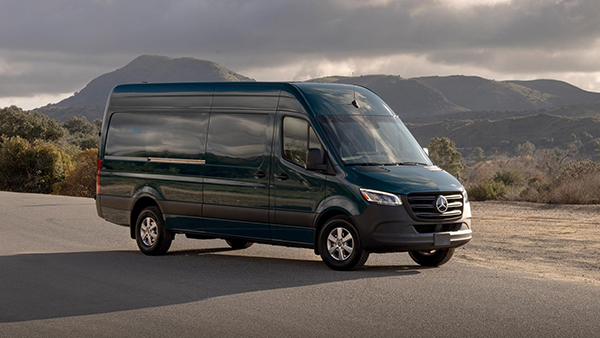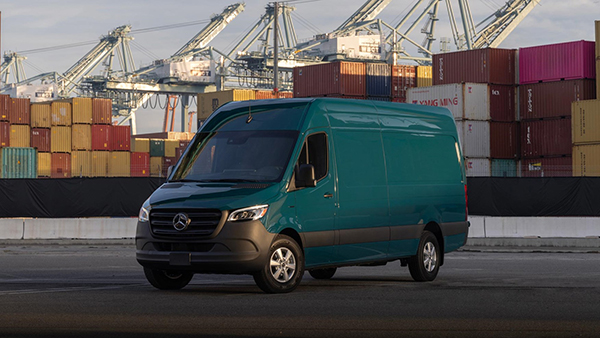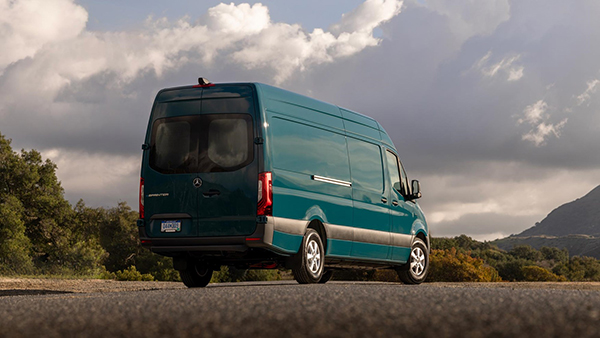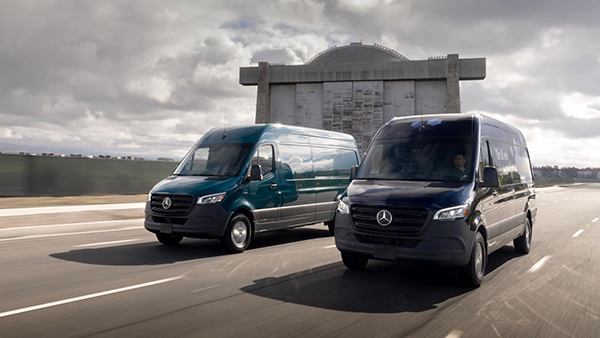All of a sudden, large electric vans have really upped their game when it comes to their range. Up until recently, the small and medium vans were setting the pace, with their bigger siblings needing to be charged after you have done 100 miles or fewer.

And that’s before you factor in a full loading bay, unpredictable routes and drivers wanting to put the heater on. How unreasonable.
This has now flipped, and it is large vans that are promising the longest ranges of all, and the Mercedes-Benz eSprinter is up there with the very best with a new battery that takes its maximum over 270 miles.
The caveat to this is that Merc is far from the only brand to be doing this. The new Renault Master and Nissan Interstar are promising a higher range at around 285 miles, while Citroen, Peugeot, Fiat and Vauxhall’s ageing vans are all heading for a similar ballpark, too.
The Ford E-Transit, which changed the game for the large electric van, offers just shy of 200 miles.
What is new for the 2024 facelift for the Mercedes-Benz eSprinter?
It’s a bit much to call the 2024 update a facelift in the usual way, as there isn’t much of a visual update for the physical van, not on the outside at least. The big changes come on the inside and underneath.
Starting with the thing that will make the biggest difference to the eSprinter – that new battery. It’s a 113kWh unit, which is one of the largest that you can get in a big van. Mercedes has also tweaked as many other things as the current Sprinter platform allows. It reckons that it has made efficiency savings of 18% overall.
This comes thanks in part to the new motor, which accounts for around 8% of the improvement, while the tyres and aerodynamic changes make up 7%. The rest is thanks to minor tweaks here and there.

There are some features included to help you make the most of that range, too, with a new brake regeneration system that claims to be able to work automatically. This is a similar setup to the one on Mercedes’ passenger cars, and is designed to be able to read the situation around you and vary how much charge it reclaims via regen.
There is also a fancy new touchscreen, which completely changes the look of the inside of the cabin. Where the 2020 eSprinter was a dour and grey affair, the latest version is much more modern in a way that feels more appropriate for an electric van that is at the forefront of its class.
So what is the 2024 Mercedes-Benz eSprinter like to drive?
It won’t shock you that the fundamental elements of the Sprinter driving experience remain unchanged and untouched. It’s still a smooth, largely silent and stress-free companion, particularly at the lower speeds that are likely to be the bread and butter for an electric van.
If you take it up to higher speeds then there is a degree of wind noise whooshing around the doors, but it is never a noisy affair.
This is all as you would expect really, as the biggest change that Mercedes has made is that you can go further before stopping to charge. The elephant in the room is the battery. Firstly the sheer size of it and the van needed to carry it.
This is a big vehicle – you can only get the 113kWh battery in the L3H2 (third longest and second highest in the range) version – and you feel every bit of it. This isn’t any larger than the diesel equivalent, but it does mean that if you want a large electric Sprinter with a big battery then you can’t do it by halves.
This means that it has a commanding presence on the road, and it is a large vehicle to drive around town. Thankfully, visibility is about as good as you can hope for, with large windows, a fantastic, high-set driving position and sensors and cameras to aid with parking. There is also a camera that provides an image on the rear-view mirror.

As is always the case with these, it takes a little adjustment as your eyes don’t focus on the image immediately due to the depth perception. However, the solid doors and bulkhead mean you won’t be able to use a standard mirror so being able to see behind a panel van is a big enough bonus to overlook that oddity.
The other factor is the weight. More on the implications of that below, but it has little notable impact on how the eSprinter drives. We drove it with a couple of hundred kilos payload on top of the battery weight, and it felt assured around corners and over the few imperfections on our test route.
There are a couple of features that are in place to help you maximise battery too. The new brake regeneration feels a bit gimmicky in some senses, and it wasn’t exactly to our taste.
It uses sensors to recognise slow-moving traffic ahead of the van, but isn’t able to pick up on stationary vehicles. This means it isn’t able to bring itself to a total halt, even in stop-start traffic. It is also said to be able to take information on the local topography from the navigation system, so it adjusts for when you are going downhill or up.
This is a lovely idea in principle, but we preferred to simply switch between the different levels of brake regen using the paddles behind the wheel. If you are hellbent on eking out every possible mile from the battery, then we would suggest doing the same.
The other eco-minded feature is the three driving modes, named ‘Comfort’, ‘Eco’ and ‘Maximum Range’. It’s nice to see them labelled appropriately – having a Power mode would feel wrong in a vehicle like this – and everything other than Eco dials back the various features to channel as much battery to the wheels as possible.

But isn’t that battery really heavy?
Ah, yes. There’s the rub. A 113kWh battery is indeed rather big. That’s why this is such a big van – it needs the length to fit it underneath after all.
It also means that it is heavy, which is not good in a van. If you have a category B car licence (everyone who passed after 1 January 1997 has one of these, unless they have done more tests since) are only allowed to drive a van that weighs 3.5-tonnes fully loaded. The top-spec 113kWh eSprinter isn’t far short of that with an empty loading bay at 3,180kg. That would only leave 320kg for everything else, and some of that has to be given over to a driver. Even if all your drivers are particularly svelte that isn’t going to cut it.
There is a loophole that allows car licence holders to drive a van with a Gross Vehicle Weight of up to 4.25-tonnes, and Mercedes is making full use of this. This means that you get a more acceptable payload of up to 1,077kg. This isn’t huge – you can carry this much on a small van like a Citroen Berlingo – but it is much better.
The other catch is that you do need to do some extra training to be allowed behind the wheel of a 4.25t electric van, it isn’t an automatic loophole.
This is something that will take extra admin, more time and more cost. But this is far from unique to the eSprinter. The Renault Master and Nissan Interstar, and all of the Stellantis large vans will have to do the same to acheive their large ranges. The E-Transit’s 196-miles ramge might look small by comparison, but someone with a standard car licence can just jump in and go.
Should I buy a 2024 Mercedes-Benz eSprinter?
In one sense the new eSprinter is a triumph. It is a huge step forward from the frankly inadequate initial version that was launched in 2020, with its sub-100-mile range and dowdy interior.
The 2024 model’s range of 271 miles is going to cover off a wide range of use cases and it has enough payload to make it worthwhile. It’s also got a cabin that befits its range-topping status and it is sublimely quiet and smooth to drive.
However, while Mercedes has removed many of the negative points about its electric flagship van, it has added in a couple of others, albeit ones that are easier to navigate and open up its appeal to a far wider range of buyers. So long as they can justify the cost.
2024 Mercedes-Benz eSprinter Big Van Massive Range
22/02/2024
No Comments
Mercedes-Benz | Mercedes-AMG
Click to rate this post
[Total: 1 Average: 5]